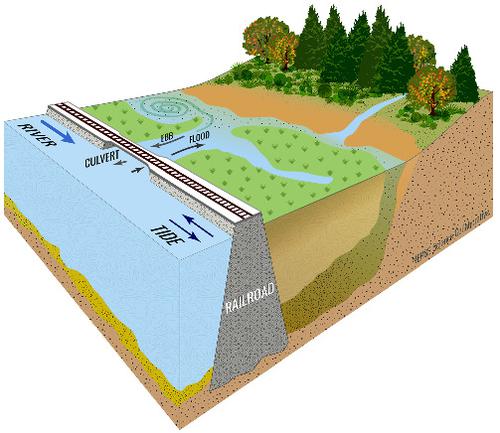当前位置:
X-MOL 学术
›
Earth Surf.Process. Land.
›
论文详情
Our official English website, www.x-mol.net, welcomes your feedback! (Note: you will need to create a separate account there.)
Rapid tidal marsh development in anthropogenic backwaters
Earth Surface Processes and Landforms ( IF 3.3 ) Pub Date : 2020-12-08 , DOI: 10.1002/esp.5045 Brian Yellen 1 , Jonathan Woodruff 1 , Caroline Ladlow 1 , David K. Ralston 2 , Sarah Fernald 3 , Waverly Lau 1
Earth Surface Processes and Landforms ( IF 3.3 ) Pub Date : 2020-12-08 , DOI: 10.1002/esp.5045 Brian Yellen 1 , Jonathan Woodruff 1 , Caroline Ladlow 1 , David K. Ralston 2 , Sarah Fernald 3 , Waverly Lau 1
Affiliation

|
Tidal marsh restoration and creation is growing in popularity due to the many and diverse sets of services these important ecosystems provide. However, it is unclear what conditions within constructed settings will lead to the successful establishment of tidal marsh. Here we provide documentation for widespread and rapid development of tidal freshwater wetlands for a major urban estuary as an unintended result of early industrial development. Anthropogenic backwater areas established behind railroad berms, jetties, and dredge spoil islands resulted in the rapid accumulation of clastic material and the subsequent initiation of emergent marshes. In one case, historical aerial photos document this transition occurring in less than 18 years, offering a timeframe for marsh development. Accretion rates for anthropogenic tidal marshes and mudflats average 0.8–1.1 and 0.6–0.7 cm year−1, respectively, equivalent to two to three times the rate of relative sea level rise as well as the observed accretion rate at a 6000+ year‐old reference marsh in the study area. Paired historical and geospatial analysis revealed that more than half of all the tidal wetlands on the Hudson River were likely triggered by anthropogenic development since the onset of the industrial era, including two‐thirds of the emergent cattail marsh. These inadvertently constructed tidal wetlands currently trap roughly 6% of the Hudson River's sediment load. Results indicate that when sediment is readily available, freshwater tidal wetlands can develop relatively rapidly in sheltered settings. The study sites serve as useful examples to help guide future tidal marsh creation and restoration efforts.
中文翻译:

人为回水中潮汐沼泽的快速发展
由于这些重要的生态系统提供了多种多样的服务,潮汐沼泽的恢复和创造正日益普及。但是,目前尚不清楚人工环境中的哪些条件会导致潮汐沼泽的成功建立。在这里,我们提供了有关主要城市河口的潮汐淡水湿地的广泛而快速发展的文档,这是早期工业发展的意外结果。在铁路护堤,码头和疏edge弃土岛后面建立的人为回水区导致碎屑物质的快速堆积,并随后引发了新生的沼泽。在一个案例中,历史航拍照片记录了这种转变发生在不到18年的时间,为沼泽的发展提供了时间表。-1分别等于研究区域内具有6000多年历史的参考沼泽的相对海平面上升速率和观测到的增生速率的2至3倍。配对的历史和地理空间分析表明,自工业时代开始以来,哈德逊河上所有潮汐湿地的一半以上可能是由人为发展引起的,其中包括三分之二的新兴香蒲沼泽。这些无意建造的潮汐湿地目前捕获了哈德逊河大约6%的泥沙量。结果表明,在容易获得沉积物的情况下,淡水潮汐湿地在庇护环境中的发展相对较快。这些研究地点可作为有用的实例,以帮助指导未来的潮汐沼泽的创建和恢复工作。
更新日期:2020-12-08
中文翻译:

人为回水中潮汐沼泽的快速发展
由于这些重要的生态系统提供了多种多样的服务,潮汐沼泽的恢复和创造正日益普及。但是,目前尚不清楚人工环境中的哪些条件会导致潮汐沼泽的成功建立。在这里,我们提供了有关主要城市河口的潮汐淡水湿地的广泛而快速发展的文档,这是早期工业发展的意外结果。在铁路护堤,码头和疏edge弃土岛后面建立的人为回水区导致碎屑物质的快速堆积,并随后引发了新生的沼泽。在一个案例中,历史航拍照片记录了这种转变发生在不到18年的时间,为沼泽的发展提供了时间表。-1分别等于研究区域内具有6000多年历史的参考沼泽的相对海平面上升速率和观测到的增生速率的2至3倍。配对的历史和地理空间分析表明,自工业时代开始以来,哈德逊河上所有潮汐湿地的一半以上可能是由人为发展引起的,其中包括三分之二的新兴香蒲沼泽。这些无意建造的潮汐湿地目前捕获了哈德逊河大约6%的泥沙量。结果表明,在容易获得沉积物的情况下,淡水潮汐湿地在庇护环境中的发展相对较快。这些研究地点可作为有用的实例,以帮助指导未来的潮汐沼泽的创建和恢复工作。


























 京公网安备 11010802027423号
京公网安备 11010802027423号